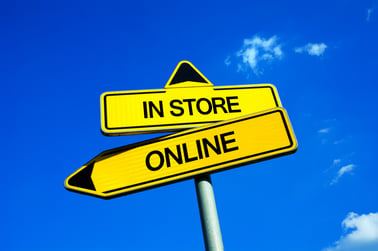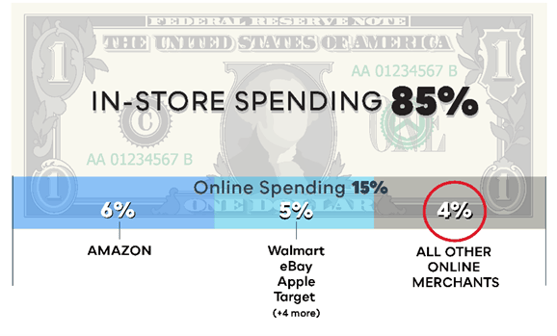Why In-Store Discounts Are Key to Boosting Your Membership Rates
Summary
-
In-store discounts are crucial for the success of any membership discount program.
-
Most discount programs only offer online discounts, which are less relevant to users.
-
Despite the growth of online shopping, in-store sales account for 85% of retail sales.
-
Access has the largest private discount network in America and provides more in-store discounts than any other program, leading to greater member engagement and retention for our clients.
The other day I was checking my credit card statement and noticed how often I and my wife go online to places like Amazon, Ebay, Etsy, and Delta Airlines, plus a myriad of other online merchants. As I reflected on how much we spend online, I shook my head wondering how we ever got by without the internet and how pretty much every purchase we made in "the old days" took place face-to-face and person-to-person.
It got me thinking…are in-store purchases still relevant to consumers, especially since so much of retail shopping now seems to happen online?
Because of the explosive growth of e-commerce, and how much we hear about it, I wondered how close we are to when online retail sales eclipses brick-and-mortar sales. It can’t be that far off. Right? So I looked it up.
Before I tell you the answer, if you were to guess what percentage of all retail sales happen online, what would be your guess? 5%? 25%? 50%? Maybe 60%?
I conducted a quick, non-scientific online poll to see what most people thought. I asked: Without looking it up, what's your guess as to the percentage of all US retail sales that occur online?
Of the hundreds of respondents, the average estimated percentage of retail sales that occurs online is 44%. So if your guess was anything more than 25%, you’d be in good company with most respondents.
However, the actual percentage of online sales according to the US Census Bureau quarterly ecommerce report is a measly 15.1%.
In other words, despite the rapid growth of online sales over the last three decades, approximately 85% of all retail sales happen at a brick-and-mortar store. Even during the pandemic, online sales peaked at 16.1% quarterly, but in the next period, that percentage dropped back to 14.3%.
When I tell people online sales account for a fraction of overall retail sales, I get a range of responses. From a quick raise of the eyebrows to gawking stares of skepticism.
The fact is we rarely hear anything about the percentage of online sales unless they’re touting how much online sales have grown year over year. While that’s an important story, rarely does it give us the necessary context about how the percentage of growth relates to the overall retail economy. The net result is we get a skewed view of reality.
And I’m not suggesting there’s some type of conspiracy. I’m merely pointing out that most business journalists tend to echo each other, without really checking the facts.
Consider the popular notion of a “retail apocalypse” for instance.” Back in 2019, it seemed everyone was predicting the demise of brick-and-mortar retailers. Well, it didn’t happen, and not even the lockdowns of a global pandemic could doom most brick-and-mortar stores.
History instead tells us that retailers have always come and gone, and they always will come and go. Innovation drives retail growth, and an inability to adapt to market forces always leads to some popular businesses closing their doors. That’s why we don’t see any more “five-and-dimes.” That’s why Blockbuster, PanAm, and Kodak are all just memories.
Why is in-store retail still so relevant?
Despite the constant flood of articles touting the explosive growth of online retail sales, in-store retailers aren’t going away any time soon. Probably not in our lifetime.
Why not?
 Think about it. There are certain things you just can't do online. Sure, you can book appointments or make reservations, but when it comes to certain services, you still need to physically be there. Need a haircut? Your car's oil changed? Or maybe a good workout at the gym? What about putting gas in your car? You can't do that through a screen. Yeah, you can order your groceries online, but most people like the control they enjoy when they go to the local grocery store. They want to select the best fruits and vegetables, they like buying Oreos or the new flavor of Lay’s potato chips on impulse. They also like browsing and discovering new items, or things they forgot to put on their shopping list.
Think about it. There are certain things you just can't do online. Sure, you can book appointments or make reservations, but when it comes to certain services, you still need to physically be there. Need a haircut? Your car's oil changed? Or maybe a good workout at the gym? What about putting gas in your car? You can't do that through a screen. Yeah, you can order your groceries online, but most people like the control they enjoy when they go to the local grocery store. They want to select the best fruits and vegetables, they like buying Oreos or the new flavor of Lay’s potato chips on impulse. They also like browsing and discovering new items, or things they forgot to put on their shopping list.
And let's not forget about restaurants. You can't have the experience of dining in a nice sit-down restaurant or bistro through a virtual interface. There's something special about having an expertly prepared meal in a pleasant atmosphere, with someone attending to your every need and cleaning up afterward.
Despite the rise of online shopping, in-store purchases will always have the upper hand when it comes to the hands-on experience. When you step into a physical store, you can touch, try, compare, and interact with products, and there’s knowledgeable staff to answer questions. It all adds that critical dimension to the shopping experience that just can't be replicated online.
And let's not forget the speed and convenience factor. For those who shop in a store, you can walk out of the store with the items or products you came in for. There’s no need to wait for shipping and handling. Plus, when it comes to savings, in-store retailers often offer better deals with higher percentages and more significant discounts compared to their online counterparts. After all, they don't have to factor in shipping charges.
Why does this matter to membership groups?
If you lead a membership-based organization, you’ve likely considered offering a membership discount program as part of your suite of benefits. Or, you already offer a discount program, but you're looking for ways to increase its value / relevance for your members.
As America’s largest private discount network, Access member benefits programs help our clients drive member engagement, boost lackluster member retention, and provide our clients with a powerful incentive to help them acquire new members.
If you haven’t considered a discount program yet for your members, or if you’re unhappy with the one you have, here’s a little secret: Not all discount programs are the same.
Some give away their discounts for free. Others require a monthly subscription fee. But of all the discount networks and platforms out there, with very few exceptions, most discount programs only deliver online merchants to your members.
Why?
Because online merchants generate back-end revenue for the discount provider from every purchase your members make. It’s called affiliate marketing. Some of these programs can be a little on the shady side, luckily, most are not. Either way, these marketing platforms can make themselves a lot of money off your members, especially if you have a large group.
But what these programs don’t offer are in-store redeemed discounts. That’s because they have no way to monetize a coupon redeemed in person.
And that means their network excludes in-store redeemed offers, or in other words, 85% of all retail merchants…because there’s nothing in it for them.
There’s no reason to bother with signing up a local restaurant, boutique, or auto lube shop on their discount network if they can’t generate revenue from the transaction.
That’s the biggest reason why they frequently offer their discount programs for free. They’ll defer charging you an upfront fee, expecting even greater revenues once they get you signed up.
What they won’t tell you is that part of the revenue they generate from the transaction comes from the discount portion that the merchant would otherwise want to go to your members. So, your members end up with a ho-hum, forgettable discount, with the average in the range of 3%-8% off retail.
The Access network, however, includes popular restaurants, main-street retailers, big box stores, auto service centers, hotels, theme parks, etc. We have over a million physical locations where our members can save. We focus on signing up locations where people are most likely to do their everyday shopping at stores they’re familiar with. Best of all, the average discount is 31% off retail.
Knowing that 85% of all retail purchases are made in a physical store matters a lot to our clients and their members. That’s why we focus so much on delivering discounts at brick-and-mortar locations. Yes, we do provide over 900 of the most popular online retailers, but they account for less than 1% of all our merchant relationships. Our network is mostly focused on popular national and regional merchants, but we also have over 20,000 small, mom-and-pop locations too. In all, 99% of our merchant partners have a physical presence.
Here’s the kicker: A few behemoth online retailers dominate the bulk of online spending, and most of them do not and will not ever offer a storewide discount through programs like Access (or any other).
So, when you exclude those retailers, an online-only discount program has far fewer relevant merchant choices for your members.
We all know that Amazon is the big gorilla in e-commerce, accounting for roughly 40% of all online sales. But in the broader context of the entire retail economy, their sales make up less than 6% of all retail sales nationwide.
Now consider the next largest eight online retailers (eBay, Walmart, Wayfair, etc.), they combine for another 5% of all retail spending. Yet, for most of these, there’s not much in the way of discounts they offer to programs like Access or any of our counterparts.
That leaves online-only discount programs with a very limited selection of popular online retailers. Together, that long list of online merchants still only generates about 4% of all retail sales in America.
In essence, if your discount program only offers online discounts, your program will be irrelevant to your members for 96% of their day-to-day purchases.
That’s why most online-only discount programs are overlooked, forgotten, and eventually ignored.
What really makes Access different is that we maintain relationships with over 30,000 different brands. Big and small. Each one requires a contract, a discount offer, and an ongoing relationship. That’s the heavy lifting your organization gets from giving your members access…to Access.
If you’d like to learn more about how discount programs work, what to look for, and what to avoid, check out this Buyer's Guide to Turnkey Discount Programs for Membership Organizations. It’s free. There’s no form to fill out, and it’s filled with tons of valuable information.
You can also check out how we’ve helped our clients succeed on our case study page. And don’t miss this article about why restaurant discounts are so important to a membership discount program.
To kick the tires on our white-labeled discount platform, click here. We’ll have one of our delightful team members arrange a completely free, no guilt-trip demo.
There’s no better way to see the power of the Access discount network than by seeing for yourself how many in-store, brick-and-mortar discounts are in your area.

Topics: Merchant Discount Network, Discount Programs, Member Benefits, member retention, local discount content, discount networks, discount program, member acquisition, private discount programs, member engagement, Acquisition, Membership Organizations, Online Facts, Discounts, membership discounts, Member Success
Written by: Gary Toyn



.jpeg)







Share your Comment.